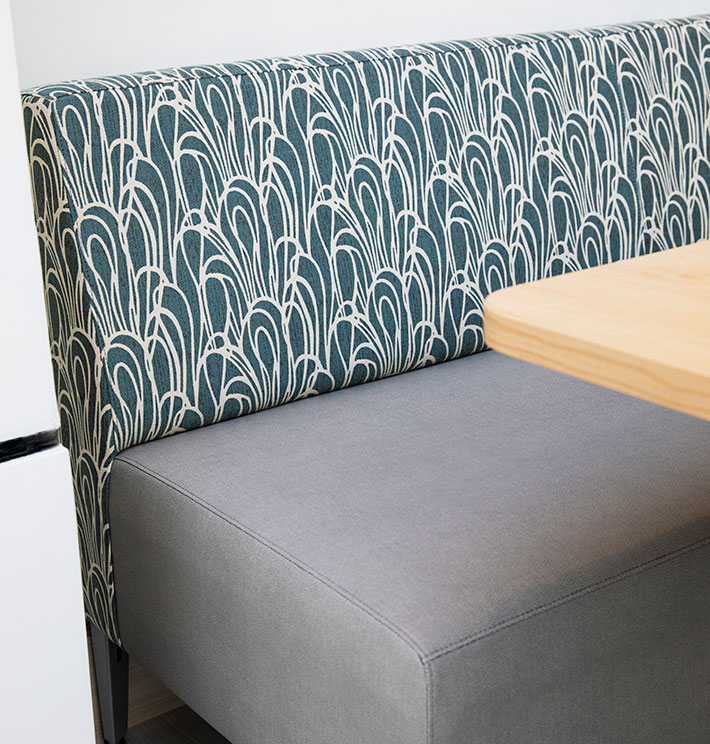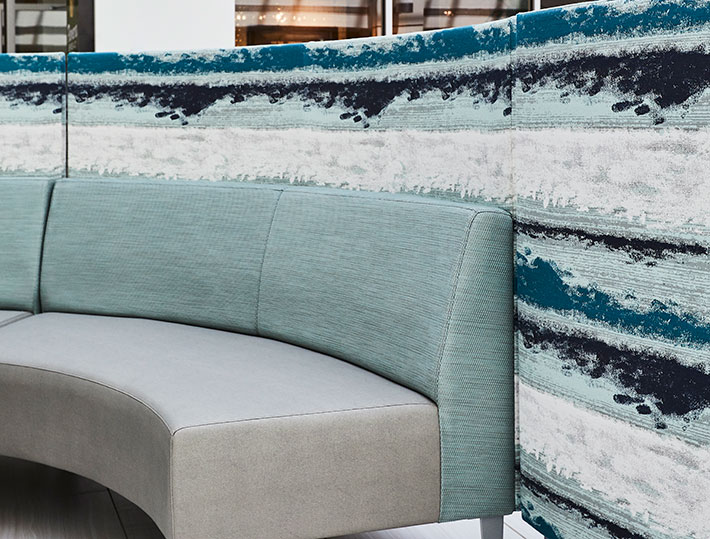
Color affects the way people feel in a room, like no other design element. It can make a space feel warm and inviting, bold and energizing or cool and museum-like. Before it was renovated, the atrium at the Moses H. Cone Memorial Hospital Campus felt dark and institutional, despite a large bank of skylights above. The reason? Brown was the dominant color in the space.
The hospital design team knew that color would be essential to updating the atrium from feeling like a cafeteria to embodying a café vibe. But they had other things to consider: Health and safety cleaning standards are top priorities health care facilities, and the atrium needed to appeal to a wide variety of people from different cultural backgrounds, income levels, live stages and health situations.
During ideation sessions that brought together patients, staff and visitors, the design team asked participants to react to mood boards that showed a variety of color palettes and finish options. Most people were drawn to saturated colors and lots of texture.
The resulting color palette of blues, greens and greys with a touch of earthy terra cotta tones features high-performance, woven Sunbrella Contract fabrics on upholstered seat backs and dividers to add softness and bring organic patterns to the space.

“(Using a woven fabric) adds further texture and complexity,” Hanson said. “It’s more comforting and has a natural feel that everybody relates to and the patterns are timeless and soft, but with personality. We wanted something upbeat, but flexible enough to stand the test of time and fit in with the overall feel.”
The atrium includes four fade-resistant Sunbrella Contract fabrics on seat backs and bench seating dividers.
- Brentano Glaze in Crystalline on the bench seating dividers presents a soft, layered, pattern inspired by brush strokes on pottery.
- Mayer Reflector in Aquamarine is a small-scale geometric pattern on the curved seat backs of modular seating.
- Stacy Garcia Arte in Mineral features layered looping lines on banquette seating along the walls.
- Mayer Reflector Indigo is a small-scale geometric pattern on booth seat backs.
Using woven high-performance Sunbrella Contract fabrics on seat backs and dividers also gives the space some texture, while remaining cleanable to the hospital’s standards. All are easily cleaned with just soap and water, but bleach can also be used when needed without diminishing the fabric colors.
Before specifying final upholstery, hospital officials put the fabrics through rigorous testing. They spilled food, including grape juice and coffee on fabric samples, allowing the spills to sit and dry on the fabric. They took fabric samples to the pediatric department and let children draw on it with felt pens, including the indomitable Sharpie marker.

“We needed to make sure we had a fabric that will stand up to stains and cleaning products that we use in healthcare,” said Joshua Andrews, executive director for food nutrition and environmental services for Sodexo at Moses H. Cone Memorial Hospital.
Andrews’s team wiped the fabrics with hospital-approved cleaners, agitated them with brushes and used an extractor on to test durability. They even used bleach during test cleaning to ensure it would not affect the fabric color.
“Bleach cleanability is very important in a healthcare setting,” Andrews added. “Unfortunately, we have very sick people and sometimes the only thing that will kill these germs is bleach.”
The hospital now has a vibrant and clean atrium filled with natural light, where its patients, staff and visitors can gather and feel at home.